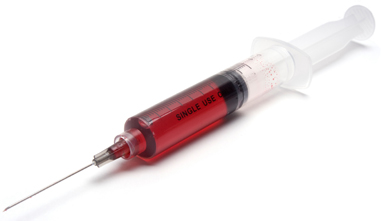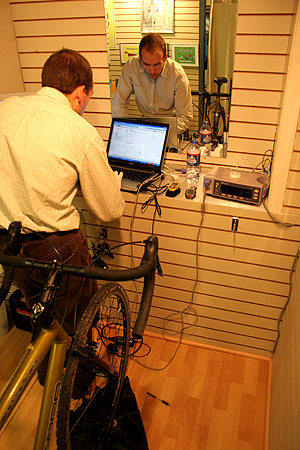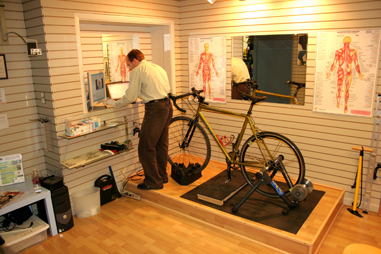Fitness in the Blood
The Gear Junkie goes under the needle for a Blood Lactate Test
By STEPHEN REGENOLD
published June 3, 2008
A vein in my forehead is about to burst. Sweat streams off my nose. I’m on a stationary bike, hooked to cords and monitors, a hamster on a wheel, legs spinning, lungs gasping, heart-rate racing to 168 beats per minute—dit-dit-dit-dit-dit-dit-dit—and climbing higher still.
“Come on, let’s hit 170!” shouts Ben Popp, founder of Endurance Athlete, a fitness-training company in St. Paul.
My fingertip is bloody, perforated already with a half-dozen pricks. My head is woozy. Then the three-minute session ends. “OK, give me that finger,” says Popp, grabbing my wrist, a medical needle in hand.

Popp is searching for my blood lactate threshold, a point where lactic acid floods muscle cells too fast for the body to metabolize the excess. This threshold is where athletes “feel the burn,” a physiological parameter at which speed, power and efficiency start to suffer under the pain of anaerobic stress.
Professional athletes, notably Nordic skiers and endurance-sports competitors, have sought blood lactate tests for more than a decade. Alongside fitness identifiers such as body mass index, VO2 max (aerobic capacity), heart rate and body composition tests, a blood lactate profile helps prescribe workout regimens individualized for the physiological makeup and fitness level of each athlete on a roster.
Indeed, blood lactate readings can distill the efficiency of exercise to a cellular level, providing a peek at the inner workings of millions of muscle cells, where oxygen, enzymes, glycogen, lactic acid and other infinitesimals mix to pound out movement and power. Trainers and coaches take test results and apply them to heart-rate-based workouts structured for maximum physical efficiency.

Popp, founder of Endurance Athlete, analyzes Regenold’s output via video and performance metrics including heart rate and lactate level on the lab’s trainer bike.
“It’s about training smarter, not harder,” said Popp, a former semi-pro skier who coached college athletes for five seasons before founding Endurance Athlete in 2001. “The goal with any workout should be to do the minimal amount of work possible to elicit the physiological response that you need to make a difference.”
With such claims, blood lactate tests are just now entering the mainstream fitness vernacular. Popp says everyday exercisers, recreational athletes and dieters can benefit from the precise fitness plans generated by a lactate profile.
“People who work 50 or 60 hours a week and have just a few hours for fitness can increase their productivity,” Popp added.
Piotr Bednarski, founder of the personal-training company Go! Training in Minneapolis, Minn., said lactate tests help athletes to ensure that they are not overdoing it. “Some citizen athletes train too hard, which is detrimental,” Bednarski said. “I can monitor somewhat scientifically when people need to cut back, or when performance is suffering.”










